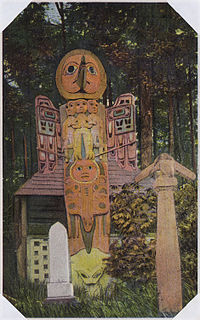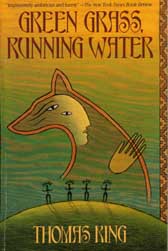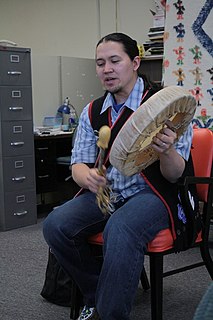The Haida are one of the indigenous peoples of the Pacific Northwest Coast of North America. Their national territories lie along the west coast of Canada and include parts of south east Alaska. Haida mythology is an indigenous religion that can be described as a nature religion, drawing on the natural world, seasonal patterns, events and objects for questions that the Haida pantheon provides explanations for. Haida mythology is also considered animistic for the breadth of the Haida pantheon in imbuing daily events with Sǥā'na qeda's.

Thomas King is a Canadian writer and broadcast presenter who most often writes about First Nations.

Hunt Emerson is a cartoonist living and working in Birmingham, England. He was closely involved with the Birmingham Arts Lab of the mid-to-late 1970s, and with the British underground comics scene of the 1970s and 1980s. His many comic strips and graphic novels have been translated into numerous languages.

In Anishinaabe aadizookaan, particularly among the Ojibwe, Nanabozho, also known as Nanabush, is a spirit, and figures prominently in their storytelling, including the story of the world's creation. Nanabozho is the Ojibwe trickster figure and culture hero.

Arthur Burdett Frost, usually cited as A. B. Frost, was an American illustrator, graphic artist, painter and comics writer. He is best known for his illustrations of Brer Rabbit and other characters in the Joel Chandler Harris' Uncle Remus books.

Raven Tales are the traditional human and animal creation stories of the indigenous peoples of the Pacific Northwest Coast. They are also found among Athabaskan-speaking peoples and others. Raven stories exist in nearly all of the First Nations throughout the region but are most prominent in the tales of the Tsimshian, Tlingit and Tahltan people.

Coyote is a mythological character common to many cultures of the Indigenous peoples of North America, based on the coyote animal. This character is usually male and is generally anthropomorphic, although he may have some coyote-like physical features such as fur, pointed ears, yellow eyes, a tail and blunt claws. The myths and legends which include Coyote vary widely from culture to culture.

The mythology of the Miwok Native Americans are myths of their world order, their creation stories and 'how things came to be' created. Miwok myths suggest their spiritual and philosophical world view. In several different creation stories collected from Miwok people, Coyote was seen as their ancestor and creator god, sometimes with the help of other animals, forming the earth and making people out of humble materials like feathers or twigs.

Nisi Shawl is an African-American writer, editor, and journalist. They are best known as an author of science fiction and fantasy short stories who writes and teaches about how fantastic fiction might reflect real-world diversity of gender, sexual orientation, race, colonialism, physical ability, age, and other sociocultural factors.

Many references to ravens exist in world lore and literature. Most depictions allude to the appearance and behavior of the wide-ranging common raven. Because of its black plumage, croaking call, and diet of carrion, the raven is often associated with loss and ill omen. Yet, its symbolism is complex. As a talking bird, the raven also represents prophecy and insight. Ravens in stories often act as psychopomps, connecting the material world with the world of spirits.
Joseph Bruchac is a writer and storyteller. He is best known for his work regarding the Indigenous peoples of the Americas, with a particular focus on northeastern Native American and Anglo-American lives and folklore. He has published poetry, novels, and short stories. Some of his notable works include the novel Dawn Land (1993) and its sequel, Long River (1995), both of which feature a young Abenaki man before European contact.

Br'er Rabbit is a central figure in an oral tradition passed down by African-Americans of the Southern United States and African descendants in the Caribbean, notably Afro-Bahamians and Turks and Caicos Islanders. He is a trickster who succeeds by his wits rather than by brawn, provoking authority figures and bending social mores as he sees fit. Popularly known adaptations of the character was originally written by Joel Chandler Harris in the 19th century, and later by Walt Disney Productions adapted it for the film Song of the South in 1946.
An animal tale or beast fable generally consists of a short story or poem in which animals talk. They may exhibit other anthropomorphic qualities as well, such as living in a human-like society. It is a traditional form of allegorical writing.

In mythology and the study of folklore and religion, a trickster is a character in a story who exhibits a great degree of intellect or secret knowledge and uses it to play tricks or otherwise disobey normal rules and defy conventional behavior.

Green Grass, Running Water is a 1993 novel by Thomas King, a writer of Cherokee and Greek/German-American descent, and United States and Canadian dual citizenship. He was born and grew up in the United States, and has lived in Canada since 1980. The novel is set in a contemporary First Nations Blackfoot community in Alberta, Canada. It gained attention due to its unique use of structure, narrative, and the fusion of oral and written literary traditions. The novel is rife with humor and satire, particularly regarding Judeo-Christian beliefs as well as Western government and society. Green Grass, Running Water was a finalist for the 1993 Governor General's Award in Fiction.
Peter Blue Cloud (Aroniawenrate) was a Mohawk poet, and folklorist.

Alaska Native storytelling has been passed down through generations by means of oral presentation. The stories tell life lessons or serve as lessons in heritage. Many different aspects of Arctic life are incorporated into each story, mainly the various animals found in Alaska. Due to the decline in the number of speakers of native languages in Alaska and a change in lifestyle amongst many of the native peoples, oral storytelling has become less common. In recent years many of these stories have been written down, though many people argue that the telling of the story is just as important as the words within.
Jay Odjick is a writer, artist and television producer from the Kitigan Zibi Anishinabeg community in Québec, Canada. He is best known for his creation Kagagi, part of a growing number of Indigenous superheroes created by Indigenous writers and artists. In 2015, Kagagi has now moved from the page to the screen in a 13-episode, half-hour animated series broadcast on APTN.
Katherine "Kat" Fajardo is an American cartoonist and author. She is known for her book cover illustrations and comics that focus on Latino culture and self-acceptance. Her debut middle grade graphic novel Miss Quinces, which is a National Indie Bestseller, was the first Graphix title to be simultaneously published in English and Spanish.












